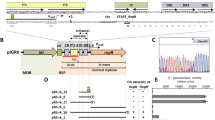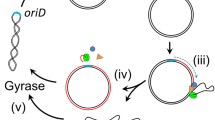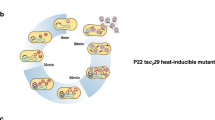Abstract
Evidence is presented that the pR bat gene is essential for plasmid replication and for spontaneous induction of the SOS response in Escherichia coli. Mutations preventing single-stranded DNA production, needed for pR plasmid replication, also prevent the induction of the SOS system. The following experimental design was used. Firstly, we identified the minima rep region, defined as the minimal DNA sequence necessary for pR plasmid replication and, secondly, analyzed the nucleotide sequence of this region. This identified structures and functions (ori-plus, on-minus and Rep protein) homologous to those found in phages and plasmids replicating by the rolling-circle mechanism. Finally, mutations were introduced either in the replication protein catalytic site or in the nick site consensus sequence, which caused the pR plasmid to lose its ability to induce the SOS system. We conclude that, in this system, the in vivo SOS-inducing signal appears to be the single-stranded DNA produced during pR replication.
Similar content being viewed by others
References
Bailone A, Galibert F (1980) Nucleotide sequence of the operators of lambda ultravirulent mutants. Nucleic Acids Res 8:2147–2164
Battaglia PA, Gigliani F, Marcucci L, Elli R (1987) The rep region of pR plasmid regulates the expression of SOS system. Mol Gen Genet 209:41–48
Craig NL, Roberts JW (1980) E. coli recA protein-directed cleavage of phage λ repressor requires polynucleotide. Nature 283:26–30
Gigliani F, Sporeno E, Perri S, Battaglia PA (1989) The uvpl gene of plasmid pR cooperates with mucAB genes in the DNA repair process. Mol Gen Genet 218:18–24
Gruss A, Ehrlich SD (1989) The family of highly interrelated single-stranded deoxyribonucleic acid plasmids. Microbiol Rev 53:231–241
Honda Y, Sakai H, Komano T (1988) Two single-strand DNA initiation signals located in the oriV region of plasmid RSF1010. Gene 68:221–228
Krishnan BR, Fobert PR, Seitzer U, Iyer VN (1990) Mutations within the replicon of the IncN plasmid pCU1 that affect its Escherichia coli polA independence but not its autonomous replication ability. Gene 91:1–7
Kunkel TA, Roberts JD, Zakour RA (1987) Rapid and efficient site-specific mutagenesis without phenotypic selection. Methods Enzymol 154:367–382
Lacatena RM, Cesareni G (1981) Base pairing of RNA1 with its complementary sequence in the primer precursor inhibits ColE1 replication. Nature 294:623–626
Lambert PF, Waring DA, Wells RD, Reznikoff WS (1986) DNA requirements at the bacteriophage G4 origin of complementary-strand DNA synthesis. J Virol 58:450–458
Lu C, Echols H (1987) RecA protein and SOS. Correlation of mutagenesis phenotype with binding of mutant recA proteins to duplex DNA and LexA cleavage. J Mol Biol 196:497–504
Moreau PL (1987) Effects of overproduction of single-stranded DNA binding protein on recA protein-dependent processes in Escherichia coli. J Mol Biol 194:621–634
Mori H, Ogura T, Hiraga S (1984) Prophage λ induction caused by mini-F plasmid genes. Mol Gen Genet 196:185–193
Mortelmans KE, Stocker BAD (1976) Ultraviolet light protection enhancement of ultraviolet light mutagenesis, and mutator effect of plasmid R45 in Salmonella typhimurium. J Bacteriol 128:271–282
Roberts JW, Devoret R (1983) Lysogenic induction. In: Hendrix RW, Roberts JW, Stahl FW, Weisberg RA (eds) Lambda II. Cold Spring Harbor Laboratory, Cold Spring Harbor, NY, pp 123–144
Sambrook J, Fritsch EF, Maniatis T (1989) Molecular cloning: a laboratory manual. Cold Spring Harbor Laboratory, Cold Spring Harbor, NY
Sanger F, Nicklen S, Coulson AR (1977) DNA sequencing with chain-terminating inhibitors. Proc Natl Acad Sci USA 74:5463–5467
Sassanfar M, Roberts JW (1990) Nature of the SOS-inducing signal in Escherichia coli. The involvement of DNA replication. J Mol Biol 212:79–96
Sedgwick SC (1986) Stability and change through DNA repair. In: Galas DJ, Kikwood TBL, Rosenberger RF (eds) Accuracy in molecular processes. Chapman and Hall, London
Southern E (1975) Detection of specific sequences among DNA fragments separated by gel electrophoresis. J Mol Biol 98:503–517
te Riele H, Michel B, Ehrlich SD (1986) Single-stranded plasmid DNA in Bacillus subtilis and Staphylococcus aureus. Proc Natl Acad Sci USA 83:2541–2545
Walker GC (1984) Mutagenesis and inducible responses to DNA damage in Escherichia coli. Microbiol Rev 48:60–93
Yoda K, Okazaki T (1991) Specificity of recognition sequence for Escherichia coli primase. Mol Gen Genet 227:1–8
Author information
Authors and Affiliations
Additional information
Communicated by B.J. Kilbey
Rights and permissions
About this article
Cite this article
Gigliani, F., Ciotta, C., Del Grosso, M.F. et al. pR plasmid replication provides evidence that single-stranded DNA induces the SOS system in vivo. Molec. Gen. Genet. 238, 333–338 (1993). https://doi.org/10.1007/BF00291991
Received:
Accepted:
Issue Date:
DOI: https://doi.org/10.1007/BF00291991




